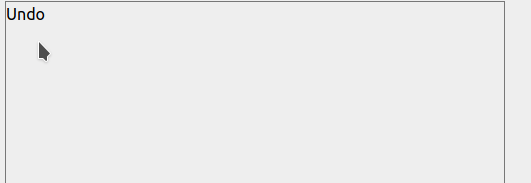A small JS library for beautiful drawing and handwriting on the HTML Canvas
Atrament is a library for drawing and handwriting on the HTML canvas. Its goal is for drawing to feel natural and comfortable, and the result to be smooth and pleasing. Atrament does not store the stroke paths itself - instead, it draws directly onto the canvas bitmap, just like an ink pen onto a piece of paper ("atrament" means ink in Slovak and Polish). This makes it suitable for certain applications, and not quite ideal for others.
Features:
- Draw/Fill/Erase modes
- Adjustable adaptive smoothing
- Events tracking the drawing - this allows the app to "replay" or reconstruct the drawing, e.g. for undo functionality
- Adjustable line thickness and colour
Enjoy!
If you're using a tool like rollup or webpack to bundle your code, you can install it using npm.
- install atrament as a dependency using
npm install --save atrament. - You can access the Atrament class using
import { Atrament } from 'atrament';
- create a
<canvas>tag, e.g.:
<canvas id="sketchpad" width="500" height="500"></canvas>- in your JavaScript, create an
Atramentinstance passing it your canvas object:
import Atrament from 'atrament';
const canvas = document.querySelector('#sketchpad');
const sketchpad = new Atrament(canvas);- you can also pass the width, height and default colour to the constructor (see note on high DPI screens)
const sketchpad = new Atrament(canvas, {
width: 500,
height: 500,
color: 'orange',
});- that's it, happy drawing!
- clear the canvas:
sketchpad.clear();- change the line thickness:
sketchpad.weight = 20; //in pixels- change the color:
sketchpad.color = '#ff485e'; //just like CSS- toggle between modes:
import { MODE_DRAW, MODE_ERASE, MODE_FILL, MODE_DISABLED } from 'atrament';
sketchpad.mode = MODE_DRAW; // default
sketchpad.mode = MODE_ERASE; // eraser tool
sketchpad.mode = MODE_FILL; // click to fill area
sketchpad.mode = MODE_DISABLED; // no modification to the canvas (will still fire stroke events)- tweak smoothing - higher values make the drawings look smoother, lower values make drawing feel a bit more responsive. Set to
0.85by default.
sketchpad.smoothing = 1.3;- toggle adaptive stroke, i.e. line width changing based on drawing speed and stroke progress. This simulates the variation in ink discharge of a physical pen.
trueby default.
sketchpad.adaptiveStroke = false;- record stroke data (enables the
strokerecordedevent).falseby default.
sketchpad.recordStrokes = true;- Atrament models its output as a set of independent strokes. Only one stroke can be drawn at a time.
- Each stroke consists of a list of segments, which correspond to all the pointer positions recorded during drawing.
- Each segment consists of a point which contains
xandycoordinates, and atimewhich is the number of milliseconds since the stroke began, until the segment was drawn. - Each stroke also contains information about the drawing settings at the time of drawing (see Events > Stroke recording).
To make drawings look sharp on high DPI screens, Atrament scales its drawing context by window.devicePixelRatio since v4.0.0. This means when you set a custom width or height, you should
also multiply the CSS pixel values by devicePixelRatio. The values accepted by draw()
and included in stroke events are always in CSS pixels.
These events fire when the canvas is first drawn on, and when it's cleared.
The state is stored in the dirty property.
sketchpad.addEventListener('dirty', () => console.info(sketchpad.dirty));
sketchpad.addEventListener('clean', () => console.info(sketchpad.dirty));These events don't provide any data - they just inform that a stroke has started/finished.
sketchpad.addEventListener('strokestart', () => console.info('strokestart'));
sketchpad.addEventListener('strokeend', () => console.info('strokeend'));These only fire in fill mode. The fillstart event also contains x and y properties
denoting the starting point of the fill operation (where the user has clicked).
sketchpad.addEventListener('fillstart', ({ x, y }) =>
console.info(`fillstart ${x} ${y}`),
);
sketchpad.addEventListener('fillend', () => console.info('fillend'));The following events only fire if the recordStrokes property is set to true.
strokerecorded fires at the same time as strokeend and contains data necessary for reconstructing the stroke.
segmentdrawn fires during stroke recording every time the draw method is called. It contains the same data as strokerecorded.
sketchpad.addEventListener('strokerecorded', ({ stroke }) =>
console.info(stroke),
);
/*
{
segments: [
{
point: { x, y },
time,
}
],
color,
weight,
smoothing,
adaptiveStroke,
}
*/
sketchpad.addEventListener('segmentdrawn', ({ stroke }) =>
console.info(stroke),
);To enable functionality such as undo/redo, stroke post-processing, and SVG export in apps using Atrament, the library can be configured to record and programmatically draw the strokes.
The first step is to enable recordStrokes, and add a listener for the strokerecorded event:
atrament.recordStrokes = true;
atrament.addEventListener('strokerecorded', ({ stroke }) => {
// store `stroke` somewhere
});The stroke can then be reconstructed using methods of the Atrament class:
// set drawing options
atrament.mode = stroke.mode;
atrament.weight = stroke.weight;
atrament.smoothing = stroke.smoothing;
atrament.color = stroke.color;
atrament.adaptiveStroke = stroke.adaptiveStroke;
// don't want to modify original data
const segments = stroke.segments.slice();
const firstPoint = segments.shift().point;
// beginStroke moves the "pen" to the given position and starts the path
atrament.beginStroke(firstPoint.x, firstPoint.y);
let prevPoint = firstPoint;
while (segments.length > 0) {
const point = segments.shift().point;
// the `draw` method accepts the current real coordinates
// (i. e. actual cursor position), and the previous processed (filtered)
// position. It returns an object with the current processed position.
const { x, y } = atrament.draw(point.x, point.y, prevPoint.x, prevPoint.y);
// the processed position is the one where the line is actually drawn to
// so we have to store it and pass it to `draw` in the next step
prevPoint = { x, y };
}
// endStroke closes the path
atrament.endStroke(prevPoint.x, prevPoint.y);Atrament does not provide its own undo/redo functionality to keep the scope as small as possible. However, using stroke recording and programmatic drawing, it is possible to implement undo/redo with a relatively small amount of code. See @nidoro and @feored's example here.
To obtain the dependencies, cd into the atrament directory and run npm install.
You should be able to then build atrament by simply running npm run build.
I didn't bother writing tests because it's such a small package. Contributions are welcome!





